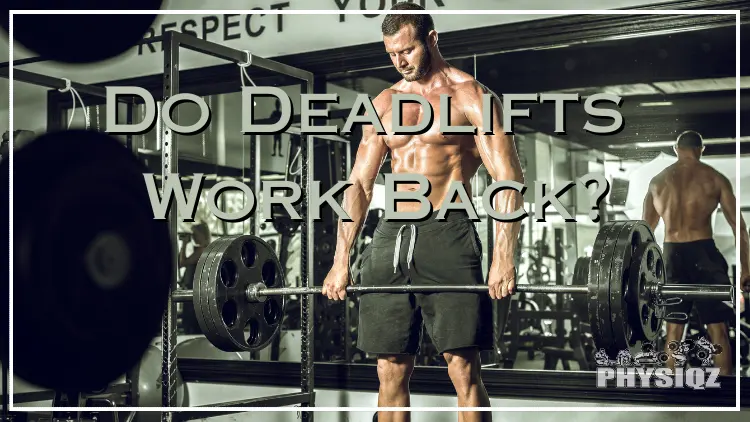
The debate over whether deadlifts engage back muscles is common in fitness circles.1
Although deadlifts involve both pushing and pulling movements—pushing with the legs into the ground and pulling the bar off the ground with the upper body—they also require activation of back muscles like the lats and spinal erectors for stabilization. Consequently, despite being primarily a lower body exercise, deadlifts recruit back muscles.
Therefore, it’s generally regarded as a leg workout, though some debate its placement on leg day versus back day.
That being said, we’ll review every muscle worked when doing deadlifts, if deadlifts alone are sufficient for training the back, the best way to program deadlifts and depending on your goals, how to feel the lower body and/or back more throughout the movement.
Deadlifts & Their Impact on Back Muscles
The deadlift is categorized as a pull type and kinetic chain compound movement using a barbell and/or dumbbell that demands activation from the posterior chain and muscles of the back.2 The posterior chain comprises muscles of the backside from the calf muscles all the way to the upper back.
They include the latissimus dorsi (lats), erector spinae (muscles that line the spine), gluteus maximus and hamstrings.
Deadlifts are not really a back exercise and should not be viewed as an only tool for growing the back muscles. However, the back muscles in particular, the upper back muscles do contribute to the deadlift by working to stabilize the lifter’s hold on the barbell through the movement.
If you suffer from low back pain or just want to build stronger muscle, then lower back exercises with dumbbells might be good for you.
This stabilization is achieved through a form of isometric (static) contraction, but it is a far cry from the contraction that is experienced by the back muscles and range of motion (the full extent which a muscle and/or joint can be move in a plane) that other back exercises provide that will lead to hypertrophy (muscle growth) and strength.
Nevertheless, it should be stated that lifters stand to gain a great deal by including a deadlift workout in their back workouts routines and will do good to place this compound movement in their arsenal of back workouts. What matters is how they are able to slot this intensive compound movement into their routines to contribute to the strength and physiques they are searching for.
What Muscles Are Worked by the Deadlift?
As mentioned before, the deadlift works primarily muscles of the posterior chain, but it also recruits other muscles such as the quads which are part of the leg muscles, back muscles (lats, rhomboids and lats) and the abdominal muscles.
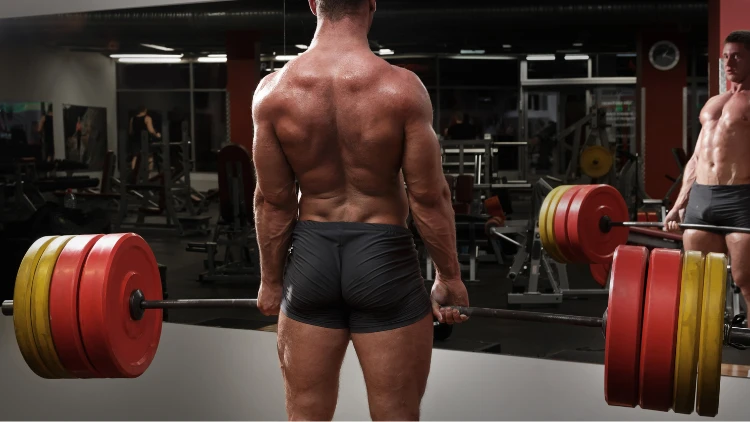
Source: Jun via Canva.com3
Latissimus Dorsi (Lats)
The lats are the largest of the back muscles and are a wing shaped muscle—these muscles are critical for the deadlift because they help the lifter keep the bar close to the body, a key technique to maintain correct form in the deadlift. This is because it allows the correct muscles that are needed in this movement to be activated.
When the bar is too far away from the torso, stabilizing muscles are forced to take over and help which is not supposed to be their role.
Upper Back Muscles (Rhomboids, Trapezius)
Rhomboids muscles line the lower neck and also make a part of both the upper and inner back muscles. Trapezius (traps) are muscles that are positioned at the back of the shoulders and they work with the rhomboids helping to support the shoulder muscles.
It is therefore of imperative importance for individuals during the deadlift to retract or pull their shoulders down and back to reduce stress on the shoulder joints.
Deadlifts effectively target the muscles of the upper back, specifically those responsible for preventing the shoulders from pulling forward and causing rounding of the spine and upper back. Without the engagement of these muscles, a lifter would struggle to maintain an upright posture at the conclusion of the lift.
Lower Back Muscles (Erector Spinae, Multifidus, Sacrospinalis)
Lower back muscles, and in particular the erector spinae muscles that line the spine help provide stability to the torso and allow the other muscles to complete the movement.
Hamstrings
These muscles located at the back of the legs serve two main functions in the deadlift; the first one is to provide stability to the knee joint and ankles during leg extension working as the antagonistic (opposing) muscle to the quads.
Their second role is working together with the gluteus maximus muscle during lock out at the top phase of the movement. The hamstrings represent one of the muscle groups activated during deadlifts, signaling proper form and technique when feeling their engagement.
Gluteus Maximus
This is the largest component of the glute muscle and is critical for a successful deadlift by having the primary role of hip extension when the lifter is executing the hip hinge (movement of the torso bending downwards in half). They help the lifter complete the lockout at the top of the movement when they are straightening their legs and moving hips forward.
It is proper technique to squeeze the glutes at the top movement during lockout.
Hip Flexors
The hip flexors (extensors) are involved in the lifting part of the deadlift since they contract against the resistance of the loaded barbell.
Quads
The quads are among the primary movers in the deadlift and work to extend the knees during the initial phase of the lift when breaking the bar off the floor. Pushing the “ground away” during the deadlift is a cue that is essential to engaging the quads as opposed to pulling the weight off the ground.
Abdominals (Obliques)
The abdominal muscles provide one of the main stabilizers of the deadlift; the main muscles involved here are the rectus abdominis (6 pack muscles) and the obliques. These muscles prevent the lifter from hyperextending their spines at the top phase during hip extension.
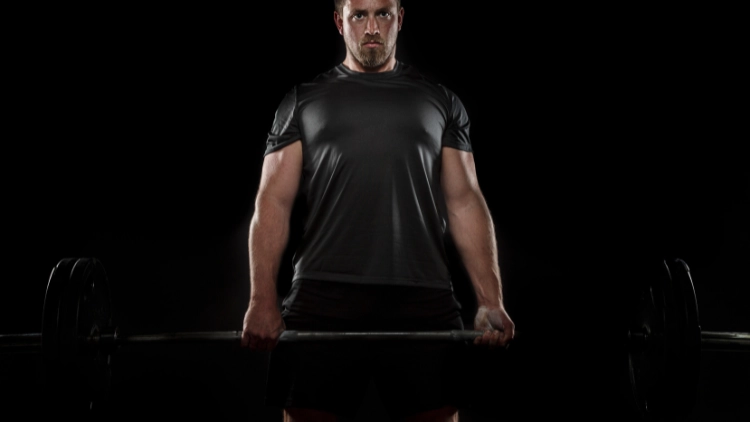
Source: steele2123 via Canva.com4
When these muscles are activated, the body will remain firm and stable and allow the bar to have an optimal path upwards.
Is Deadlift Primarily a Back or Leg Exercise? Do Deadlifts Work Legs or Back More?
Both the legs and back get a workout during the deadlift, but the back gets less of a workout than the legs. The list above clearly covers the majority of the back muscles; both lower and upper back are covered giving the impression that the back does get an intensive workout.
However, this is not entirely true.
What the deadlift fails to do is work these back muscles in their full range of motion (ROM) and their intended mechanics of movements. To achieve efficient and superior hypertrophy rates, muscles must be worked in their full range of motion as opposed to partial ROM’s—the lats, rhomboids and traps are not being contracted through their full ROM.5
Doing so, that is attempting to put them through their full ROM can place the lifter at a mechanical disadvantage during the lift and also increases the risk on injury.
Deadlifts engage back muscles, albeit with a limited range of motion, which may result in some muscle size and growth, but not necessarily superior strength gains. Research shows strength can be achieved in the back muscles or any other muscles for that matter only when they are put through their full ROM.
Because exercises are typically categorized by the muscle groups they use as primary movers which also receive the most training stimulus, then the deadlift would be considered by this merit as a leg exercise. By implication, this means that the leg muscles do receive more muscle activation than back muscles. Deadlifts are also typically and generally programmed around leg days in many training programs.
Studies have also shown both the deadlift and back squat can both successfully be included in training programs that seek to increase gains in lower body maximal strength, further advocating the case for the deadlift as a leg day workout.6
However, because the deadlift elicits both back and leg activation, it can also therefore be considered to be both a back and leg exercise.
Are Deadlifts Sufficient for Back Training? Should You Only Train Deadlifts for the Back?
There is a legitimate case for the deadlift to be a sufficient back training tool and this may fall under 3 scenarios:
Time and Efficiency—For many lifters who are still engaged in the hustle and bustle of life, there is simply not enough time to spend at the gym to rotate through all the back workouts. In these cases, it would be more logical to place priority on compound movements to maximally train the entire body in a workout.
Deadlifting allows lifters who are on a time crunch to exercise most of their back while also hitting the posterior chain, abdominals and quads.
For Bodybuilders—As mentioned earlier, deadlifts can effectively build muscle in the back, and those striving for bodybuilder physiques or preparing for bodybuilding competitions may choose deadlifts as their exclusive back-building exercise. The deadlifts in these cases may hit the muscles of the back without compromising ratios and proportions to conform to what judges may be looking for in contests.
The Powerlifter About to Enter Into a Competition —Before going into a powerlifting competition, powerlifters need to deload on volume to allow their body to recover from intense back training sessions. In these scenarios, powerlifters would train a few sets of deadlifts at a moderate rate of intensity, and pay attention to the lifts they will be competing in.
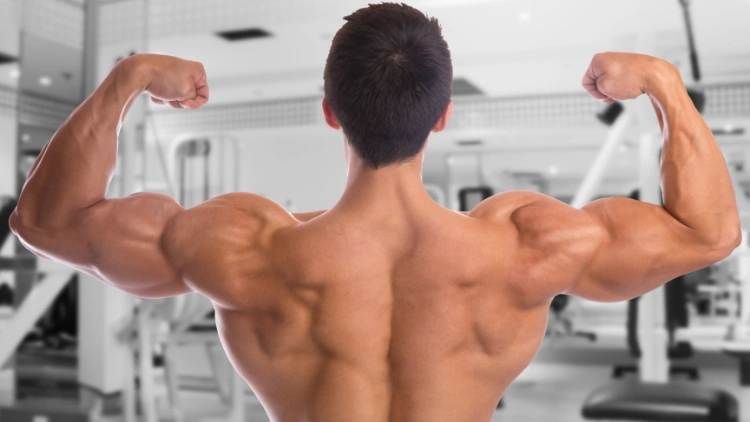
Source: Boarding1Now via Canva.com7
Barring these cases, most individuals will need to include other back workouts other than deadlifts, while some may not and this will depend on certain other factors—these are raw stimulus magnitude (RSM) and stimulus to fatigue ratio (SFR).
Raw Stimulus Magnitude (RSM)
The RSM is the amount of muscle that can be yielded per set of exercise. The deadlift has an extremely high RSM and gives the biggest back for the buck for individuals who are not looking to dedicate a lot of time in the gym and are perhaps working out 3 times a week.
Beginners easily fall in this category and stand to gain the most from deadlifting.
The Stimulus to Fatigue Ratio (SFR)
This can be defined as the adaptations of muscle growth that a workout can yield in relation to how much fatigue the exercise generates and forces the lifter to recover from. The deadlift is an extremely taxing exercise requiring heavy weights and warm ups, draining and depleting the body’s resources.
However, for all its intensity, it does not return favorable hypertrophy rates that would be expected from such a taxing workout—the deadlift essentially has a poor SFR.
Deadlifts would better suit beginners than more advanced lifters looking to grow their backs and are better positioned to getting specific stimulus from other backs exercises. These advanced lifters may want to avoid the massive fatigue that comes with the deadlift, without providing no real concrete gains in terms of hypertrophy rates and strength.
Many experienced lifters sometimes completely opt out deadlifts from their regimens.
What Are the Drawbacks of Using Only Deadlift for Back Training?
Deadlifts do present lifters with some disadvantages and drawbacks if they are to be relied on as the sole back building exercises. Some of the limitations include limiting ROM’s and movement restrictions.
ROM Limits—The majority of the back muscles in the deadlift simply don’t get a full ROM and consequently will not achieve enough stimulation that would confer strength gains. The erectors in the lower back are the only muscle group that work the full ROM, but the lats, rhomboids and traps fail to reach their true ROM potential.
Volume Restrictions—Deadlifts are one of the most taxing exercises out there, more than other compound movements such as back squats. Due to this high intensity of the deadlift, the movement has an upper limit of training volume that is not high.
Getting enough training volume is an important pillar to getting results from a strength training regimen—that is both strength and mass, and deadlifts fail to deliver on this.8 This is the reason isolation exercises for the back are ideal, as they allow lifters to train the back even after exhausting heavy compound work.
Limiting Movements—Deadlifts deny the back muscles the requirement that results in an effective contraction of the muscle that leads to strength. For example, when the lifter is pulling the bar up the torso in the deadlift, the lats get an effective activation—this snapshot cannot however be compared to a lat pull down where the load is being pulled and the muscle is simply not being used to stabilize the load.
The same goes with the rhomboids when performing rowing exercises that demands them to fully flex and retract as opposed to just stabilizing the shoulders in the deadlift.
Deadlift Workout: Should I Do Deadlift on Back or Leg Day?
The choice to do deadlift on back or leg will depend on what the training goals the lifter is looking for in the program and the intensity of the deadlift that will be performed on that day. Some beginner programs, like the Greyskull LP, best powerbuilding for beginners, incorporate the deadlift alongside back exercises like barbell rows and/or chin ups.
Other programs tailored for beginners, like the Starting Strength routine, match the deadlift with the barbell squat.

Source: chrisgraphics via Canva.com9
At lower intensity, the deadlift can be considered either a leg or back workout. However, at higher intensity, the deadlift may have a training day dedicated solely to itself and with some movements dedicated to the primary movers once the lifter is done with the deadlift such as hamstrings curls and good mornings.
Good mornings happen to be a deadlift accessory which can help address weaknesses that a lifter can have in their conventional deadlift, such as sticking points and/or technique imperfections. Sticking points are positions in any part of the ROM where a lifter has difficulty continuing the movement.
Considering the demanding nature of deadlifts, programs that include them on leg days may need to reduce intensity or volume to ensure effective leg workout performance. This raises the question of whether deadlifts should be scheduled on back or leg days. The following programming outlines how to incorporate deadlifts into either a back or leg day routine.
Programming Deadlifts for Back Days
When utilized as a training method for building the back, deadlifts effectively engage back muscles. They serve as a valuable tool for back development, providing lifters with an advantage in growing back muscles.
Without a doubt, the deadlift activates the majority of the back muscles, not in actively contracting manner, but rather in an isometric manner working mostly as stabilizers to the movement—these are of course the rhomboids, traps and part of the lats. However, the muscles of the lower back, and in particular, the erector spinae and the lower lats do work in a full ROM and receive a significant amount of fatigue during the exercise if performed with correct technique and form.
Therefore, to perform any other back workouts that recruit these lower back muscles, these exercises must be done in moderate intensity so as to not compromise their efficiency and effectiveness due to them being already fatigued.
Thus, to preserve the intensity of these other back workouts that will be done on the same day as the deadlift, there will be need to be some form of compromise on the deadlift as a back workout—it should be done moderately, with lower levels of resistance, having low repetitions (reps) and falling in the range of 7-8 on the Borg rating of perceived exertion (RPE) scale.
The Borg’s RPE scale is a measure that rates the exertion and breathlessness of an exercise, essentially measuring its intensity.10 This rating means the lifter should have 2-3 more reps in reserve (RIR).
RIR, or Reps in Reserve, indicates how many reps a lifter can perform before reaching failure during an exercise. Learn more about RPE in lifting (RIR). To put it plainly, the RPE is the inverse of the RIR—for example, when a lifter has only done one rep, their RPE is expected to be low at 1 since they have not exerted themselves, but their RIR would be 9 meaning they can still perform 9 more reps before reaching training failure RPE.
This lower intensity of deadlifts will work well combined with additional compound movements that target the back such as pull ups and barbell rows which will not have their efficiency negated by the deadlifts.
Programming Deadlifts for Leg Days
It was established earlier from studies and solved that the deadlift can truly be considered a leg workout due to recruitment of the same primary muscles as leg workouts such as the back squat. This categorization also carries over, and results in a simpler inclusion in leg workout days as opposed to back days.
However, just like with a back day, the intensity of the deadlift will also have a direct impact on the leg workout.
This is not to say that the deadlift cannot be performed at maximum intensity. On the contrary, it can, provided that is the first of exercises done before proceeding to leg workouts for a squat and deadlift same day routine.
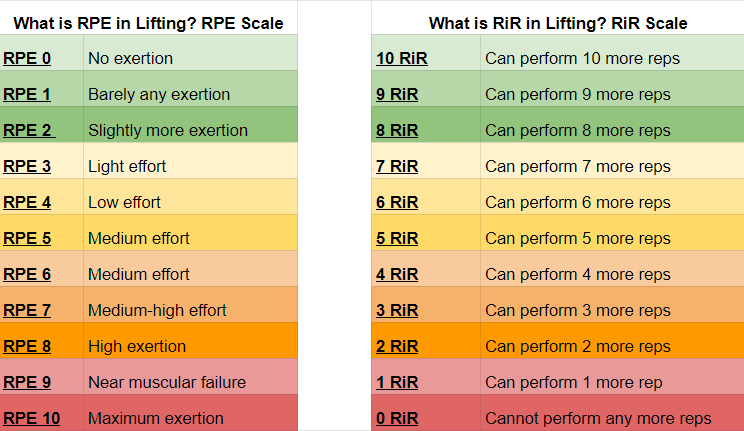
Doing the deadlift as the first exercise will ascertain that there is no compromise in form from fatigued muscles trying to complete the movement which can be dangerous and cause injury. Leg exercises such as barbell squat and/or leg presses in this routine will then count as complimenting exercises to complete the muscle stimulation for the workout session.
Deadlifts can also follow compound lifts for legs, like squats, since squats may not be as demanding. They can also serve as a warm up for the deadlift exercise working to get blood into the posterior chain that is critical for a successful deadlift. However, in this set up as opposed to the aforementioned one means that deadlift cannot be done at full intensity.
How To Make Deadlifts Target Your Legs More
It is possible to alter the deadlift to work the leg muscles more, to increase focus on them and reduce it on the back muscles. This is accomplished by introducing variations of the deadlift that target the leg muscles more such as the trap bar deadlift and sumo deadlift.
Since the deadlift has the quads, glutes and hamstrings oscillate between concentric (shorten) and eccentric (lengthen) phases, there is a significant stimulation of these muscles to achieve hypertrophy in these variations
Trap Bar Deadlift—The trap bar deadlift uses a device known as the trap and/or hex bar. The deadlift is performed in the same way as the conventional deadlift, but this contraption allows the knees and hips to lean forward placing the torso in a more upright position.
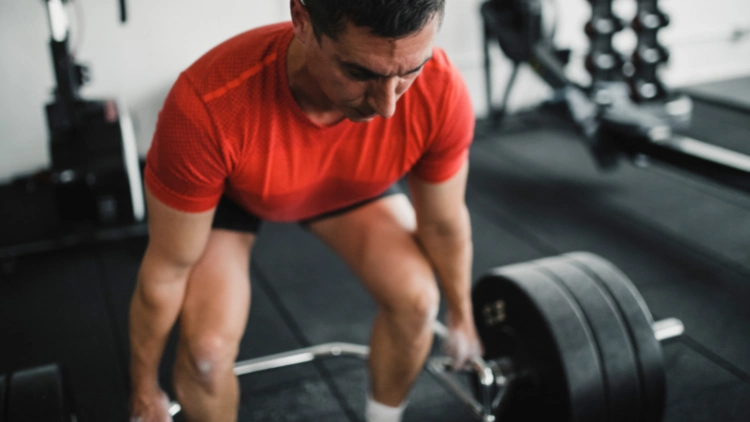
Source: SolStock via Canva.com11
As a result, there less stress placed on the lower back and increased engagement of the vastus lateralis (one of the components of the quad muscle) due to a longer ROM that the knee joint traverses.12 Therefore, the trap bar deadlift muscles worked are biased towards the leg muscles when compared to the conventional deadlift.
Sumo Deadlift—Sumo deadlift is popular among powerlifters, and is performed with a wider stance with legs being outside the arms. This results in an upright position just as with the trap bar deadlift, which places an increased demand on the vastus medialis and vastus lateralis (quad muscles) and adductors (inner thigh muscles) while also easing the pressure on the lower back.13
Deficit Deadlift—Deficit deadlift can also be used to bring more focus to the legs. Since they are performed on an elevated surface, the ROM increases for both the hips and knees.
This results in an increased targeting of the glutes, hamstrings and quads since the movement now resembles a back squat.
Ways of Making Deadlifts Target the Back Better
It is possible to make the deadlift better at focusing on the back for those who enjoy doing these lifts and/or lifters looking to always include it in a back workout routine—these include introducing deadlift variations and changing the technique in which the compound movement is performed.
Adjustments to the Technique
There are 2 adjustments that lifters can make to their deadlifts to bring the back into focus, and these are mainly altering the grip width and changing the angle of the torso in relation to the ground.
Changing Grip Width—Changing the grip width is an easier option for altering the deadlift technique. When the lifter widens the grip, as in the grip width used in the snatch known as a snatch grip, there is a greater demand placed on the rhomboids, lats and traps to allow the lifter to hold the bar.
Those accustomed to rounding their backs in the deadlift due to weak back muscles can incorporate this technique for a while. As an added bonus, the ROM increases this way because the end phase has the barbell end up 2-3 inches higher on the waist than conventional shoulder width stance.
This leads to stronger erector muscles.
Altering the Angle of the Torso Relative to the Ground—Performing different variations of the deadlift such as sumo and deficit deadlifts will result in a change in how much that lifter will have to hinge over to lift the weight. It is also possible to combine both these changes to the techniques in one movement.
Introducing Variations
Different variations of the deadlift will determine the emphasis placed on the back relative to one another. The best deadlifts for back are the snatch deadlift that uses a wider stance and the stiff legged deadlift which is similar to the conventional deadlift but has the lifter have their hips commence at a higher position.
This change means that the back is almost parallel to the ground and the knees straighter than the conventional deadlift. These changes produce a deadlift that recruits the back muscles, glutes and hamstrings heavily and demands less from the quads.
Other variations of the deadlift include:
- Romanian deadlifts
- Isometric deadlifts
- Negative tempo deadlifts
- Paused deadlifts
- Block pull/rack pull deadlifts
The debate surrounding deadlifts is understandable, as they involve both back and leg muscles, leaving lifters questioning their effectiveness for back muscle engagement. This study clarifies that while deadlifts primarily target leg muscles, they can still be included in either leg or back day workouts, depending on the lifter’s training objectives.
Frequently Asked Questions
Does the Deadlift Work the Back More Than the Legs?
No, the legs receive more of a workout than the back. This is because the back muscles work and contract in an isometric way while not moving at their full range of motion.
The deadlift is considered more of a leg workout since it involves the extension of the glutes, hamstrings and quads that receive more of a workout.
Can Deadlifts Build a Big Back?
The deadlift can build an upper back, but not on their own. For lifters to get a thick, wide back, they will need to include pulling exercises that engage and move the back muscles in a full range of motion such as barbell rows, lat pull downs and chin ups.
Can Deadlifts Make You Ripped?
Deadlifts are intensive and taxing compound movements that employ the use of heavy weights which stimulate the body to release anabolic hormones that promote fat burning and therefore weight loss. Therefore, in the long term, they will result in a lifter getting more lean and ripped.
Do Deadlifts Make the Back Muscles Sore After a Workout?
It depends. The deadlift places enormous amounts of stress on the lumbar spine (lower back) which means that it could get sore after a workout, particularly for lifters who are new to the movement. Lifters who use incorrect form during the deadlift by rounding their back could also get some back pain and muscle soreness after the workout.
Are There Any Back Muscles That Are Not Targeted by the Deadlift?
The majority of the back musculature does receive an activation from the deadlift. However, the contractions are only for stabilizing the movement, which means that most of these back muscles with the exception of the lower back muscles do not move in their full range of motion.
Does the Sumo Deadlift Train the Back?
Yes, the sumo deadlift just like the other variations of the deadlift does engage the back muscles. Due to having a wider stance, it does nevertheless engage the quads more and also places less pressure on the lower back when compared to conventional deadlifts.
Can Deadlifts Target the Glutes?
The deadlifts employ the glutes as one of the primary movers of the movement and they are crucial in hip extension during the hip hinge. They are also involved at the top of the movement in their role for completing a successful lockout when the lifter squeezes them.
Do Deadlifts Engage Muscles in the Lower Back?
Yes, the deadlift does work the lower back muscles by providing stability to the torso and allowing the other muscles that are involved in the lift to successfully fulfill their roles. Consequently, out of all the back muscles, the lower back muscles are the only ones to work in their full range of motion.
Do Deadlifts Target Muscles in the Upper Back?
The deadlifts do work the back muscles of the upper back helping to stabilize the shoulder joint and prevent rounding of the spine. These include the rhomboids, trapezius and lat muscles.
What’re the Benefits of Deadlifts?
Deadlifts can confer the lifter with a myriad of benefits. These include:
- Improves athletic performance such as jumping.
- Reduces lower back pain by building stronger backs.
- Boosts the body’s metabolism.
- They are a complete body workout targeting a majority of the body’s muscles.
- Deadlifts are an intensive exercise to build the abdominals.
- This exercise also helps burn fat and therefore aids in weight loss.
- They build stronger legs.
- Deadlifts are a calorie burner.
- Stimulates muscle growth.
- Increases bone density making them stronger and less prone to breakage.
- Improves the posture of the lifters.
- Enhances grip strength.
References
1Ozimician. “Deadlifts in modern gym.” Canva. Accessed 12 April 2023. <https://www.canva.com/photos/MADFHsIRfUw-deadlifts-in-modern-gym/>
2Isabel Martín-Fuentes, J. M.-L. (2020, February 27). Electromyographic activity in deadlift exercise and its variants. A systematic review. Retrieved 2023, from <https://www.ncbi.nlm.nih.gov/pmc/articles/PMC7046193/>
3Jun. “Strong man doing deadlift.” Canva. Accessed 12 April 2023. <https://www.canva.com/photos/MADDBxalmjA-strong-man-doing-deadlift/>
4steele2123. “Deadlift.” Canva. Accessed 12 April 2023. <https://www.canva.com/photos/MAEJGuuZ74c-deadlift/>
5Daniel E Newmire, D. S. (2018, September). Partial Compared with Full Range of Motion Resistance Training for Muscle Hypertrophy: A Brief Review and an Identification of Potential Mechanisms. Retrieved 2023, from <https://pubmed.ncbi.nlm.nih.gov/29985227/>
6Federico Nigro, S. B. (2020, July). A Comparison Between the Squat and the Deadlift for Lower Body Strength and Power Training. Retrieved 2023, from <https://www.ncbi.nlm.nih.gov/pmc/articles/PMC7386153/>
7Boarding1Now. “Bodybuilder bodybuilding flexing muscles posing gym back biceps.” Canva. Accessed 12 April 2023. <https://www.canva.com/photos/MADFM5cPAug-bodybuilder-bodybuilding-flexing-muscles-posing-gym-back-biceps/>
8BRAD J. SCHOENFELD, B. C. (2018, December 18). Resistance Training Volume Enhances Muscle Hypertrophy but Not Strength in Trained Men. Retrieved 2023, from <https://www.ncbi.nlm.nih.gov/pmc/articles/PMC6303131/>
9chrisgraphics. “Young strong man posing and flexing his quadriceps legs muscles.” Canva. Accessed 12 April 2023. <https://www.canva.com/photos/MADmePeRQJU-young-strong-man-posing-and-flexing-his-quadriceps-legs-muscles/>
10Prevention, C. f. (2022, June 3). Perceived Exertion (Borg Rating of Perceived Exertion Scale. Retrieved 2023, from <https://www.cdc.gov/physicalactivity/basics/measuring/exertion.htm>
11SolStock. “Deadlifting a Weighted Bar.” Canva. Accessed 12 April 2023. <https://www.canva.com/photos/MAEIyC-u1uo-deadlifting-a-weighted-bar/>
12Jason Lake, F. D. (2017, December). Effect of a Hexagonal Barbell on the Mechanical Demand of Deadlift Performance. Retrieved 2023, from <https://www.ncbi.nlm.nih.gov/pmc/articles/PMC5969032/>
13Rafael F Escamilla, A. C. (2002, April). An electromyographic analysis of sumo and conventional style deadlifts. Retrieved 2023, from <https://pubmed.ncbi.nlm.nih.gov/11932579/>